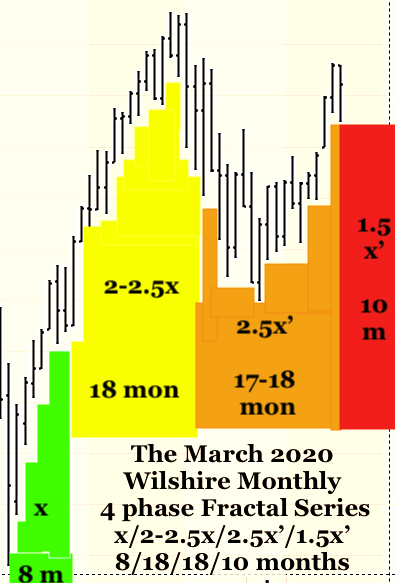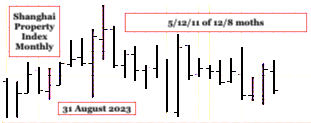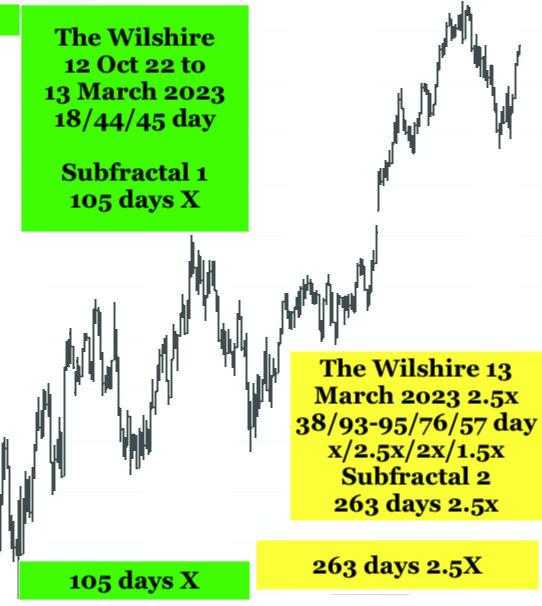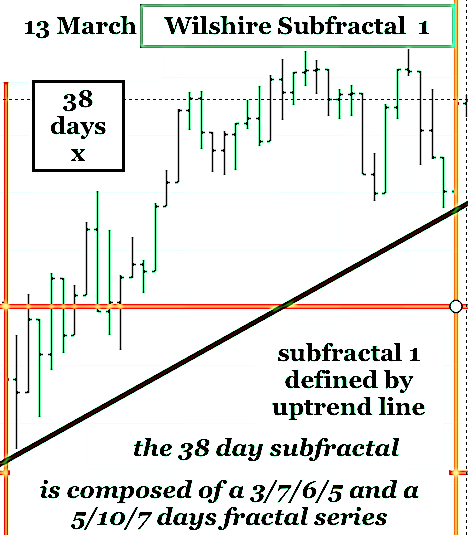31 August 2023
The Global Asset Debt Macroeconomic system is interlinked. Property overvaluation in China relative to wages and downpayment requirements (80 percent on the first residence) and grossly underwater Chinese large construction companies such as Evergrande and Country Garden who are unable to repay the interest on their debt and unable to construct promised residencies that have been financed, place residency valuations on an overhanging cliff that is beginning a nonlinear collapse.
Compare the expected termination of the monthly 4 phase fractal pattern(s) of the Wilshire (or CAC, DAX, or Nikkei) composite(s) to that of the expected termination of the monthly 4 phase Shanghai property index, the latter which is identical to that of the Bank of Shanghai.
The March 2020 Wilshire is following an 8/18/17/2 of 10 month 4 phase fractal series which is expected to end in 8 months.
The July 2021 monthly 4 phase fractal series for the Shanghai Property Index (the same as the July 2021 Bank of Shanghai) is 5/12/11 of 12/8 months ending in 8 months.
From the Wilshire’s low on 12 October 2022 a 18/44/45 day three phase fractal series of 105 days in length and ending 13 March 2023 was followed by a 13 March 2023 four phase fractal series of 38/83 of 93-95/76/57 day fractal series which would complete the remainder of the expected 8 months.
Subfractal 2 (second fractal, old term)) nonlinearity for the 38/83 of 93-95 day subfractal 1 and subfractal 2 series is expected over the next 10-12 trading days.
The Bank of Shanghai is following a three phase daily unit series starting 27 June 2023: 10/25/13 of 25 days which is expected to also end in 12 trading days.
Expect unexpected second fractal nonlinearity.
A Primer on Fractal series
The beginning and ending boundaries of time based fractal series are defined by uptrend and downtrend lines with positive and negative slopes, respectively, that are formed by connecting the two low points at the beginning and the end of the fractal series.
In a bar chart, unit bars can be minutes, hours, days, weeks, months, and years. It is the hypothesis of this website that the asset debt macroeconomic system is deterministic and the growth and decay of the ongoing unit time valuations of its asset classes automatically self assembly in the most efficient manner with self similar fractal patterns of the unit time based bars.
There are only two elegantly simple laws of self-assembly time-based fractal asset-debt valuation growth and decay macroeconomics:
While money and credit growth (and contraction)by central banks and government spending is periodically irregular, equity and commodity composite valuations grow and decay by only two distinct time-based fractal patterns(mathematical laws):
a three phase pattern: composed of three subfractals:1/2/ and 3 :: x/2-2.5x/1.5-2.5x – where x is the base first fractal time length in days, weeks, months, and years.
and a four phase pattern: composed of 4 subfractals: 1/2/3/ and 4 :: x/2-2.5x/2-2.5x/1.5-1.6x, where x is the base first fractal time length in days, weeks, months, and years. In a four phase fractal series the sum of the length of subfractal 1 and 2 may be exceeded by the sum of the length of subfractal 3 and 4 by 0.1x.
The time length of subfractal 2 (2-2.5x) of the 3 and 4 phase fractal series often determines the ideal time length of subfractal 1 : (x’) upon which the lengths of sub-fractals 3 and 4 are based: e.g., the 4 phase fractal pattern’s time lengths become x/(2-2.5x divided by 2.5 = x’)/2-2.5x’/1.5-1.6x’.
The US Hegemony macroeconomic system is following an 1807 4 phase fractal series of 36/90/90/54 years with a 90 year Subfractal 3 high on 8 November 2021 for for the Wilshire and Bitcoin/USD. Smaller unit time based fractal series make up the 36,90,90 and upcoming 54 years.



